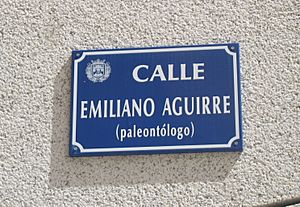Emiliano Aguirre facts for kids
Quick facts for kids
Emiliano Aguirre
|
|
|---|---|

Aguirre in 2007
|
|
| Born |
Emiliano Aguirre Enríquez
5 October 1925 |
| Died | 11 October 2021 (aged 96) Burgos, Spain
|
| Known for | Beginning the study of Atapuerca sites |
| Scientific career | |
| Fields | Paleontologist |
Emiliano Aguirre Enríquez (born October 5, 1925 – died October 11, 2021) was a famous Spanish paleontologist. A paleontologist is a scientist who studies fossils to learn about ancient life. Emiliano Aguirre is best known for his important work at the Atapuerca archaeological site in Spain. He led the excavations there from 1978 until he retired in 1990. In 1997, he received the Prince of Asturias Award, which is a very important honor in Spain.
Contents
Biography
Emiliano Aguirre was born in Ferrol, a city in Galicia, Spain, on October 5, 1925. He studied many different subjects. He learned about humanities and philosophy, then natural sciences at the University of Madrid. He also studied theology. He earned a PhD in biological sciences. His special project was about extinct elephants.
Early Discoveries
Between 1955 and 1956, Aguirre searched for dinosaur sites in the Tremp Basin. He helped dig up the bones of a dinosaur called Abditosaurus. From 1956 to 1961, he found thirty new fossil sites in Granada. These sites contained fossils from the Cenozoic Era, which is the time period we live in now.
Aguirre started his first big digs in the 1960s. From 1961 to 1963, he worked with another scientist, Francis Clark Howell. They excavated the Torralba and Ambrona site. They used new ways of working that involved many different types of scientists.
In 1963, Aguirre designed the Arbona Museum. This was the first museum in Europe to show fossils in situ, meaning they were displayed exactly where they were found. Also in 1963, he was part of a Spanish team that helped save historical sites in Nubia, Sudan. There, he studied human remains from an ancient burial ground. In 1968, he traveled to South Africa to study early human fossils. He also went to Kenya to dig in the Tugen Hills with archaeologist Louis Leakey.
In 1974, Aguirre joined the Spanish National Research Council as a researcher.
Teaching and Academia
Emiliano Aguirre was a professor of paleontology at the University of Zaragoza from 1978 to 1982. He then taught at the Complutense University of Madrid from 1982 to 1984. On May 24, 2000, he became an honorary member of the Spanish Royal Academy of Sciences. He held this special position until he passed away. He also guided 26 students through their doctoral studies.
Sharing Evolutionary Ideas
In the 1950s, when Emiliano Aguirre started his career, it was hard to talk about Charles Darwin's theory of evolution in Spain. This was because of the government at the time. But Aguirre worked hard to promote science. He organized talks, meetings, and published scientific papers.
In 1962, he gave a lecture called "Paleontological problems and natural selection." In this talk, he supported the modern theory of evolution. This was different from the ideas that were common back then.
In 1966, a very important book called La Evolución (The Evolution) was published. Aguirre helped lead this project. The book helped spread ideas about evolution in Spain. It included articles from many scientists who supported the modern theory of evolution. One paleontologist, José Luis Sanz, said in 2006 that thanks to Emiliano Aguirre, Spanish evolutionary paleontology finally became modern.
Leading the Atapuerca Site
Emiliano Aguirre began working at Atapuerca in 1976. He was the first paleontologist to understand how important this archaeological site was. He became its first director in 1978. He stayed in this role until 1990, when he retired. After him, José María Bermúdez de Castro, Juan Luis Arsuaga, and Eudald Carbonell took over. At that time, science did not get much support. So, Aguirre was in charge of training all the people who studied Atapuerca.
Personal Life and Death
Emiliano Aguirre married Carmen Bule in 1975. He passed away in Burgos, Spain on October 11, 2021. He died just six days after his 96th birthday.
Honors and Awards

- Prince of Asturias Award (1997)
- Medal of Honor for the Invention of the García-Cabrerizo Foundation (1997)
- Medal of Merit in Labour (1999)
- Four special books (called festschrift) were published in his honor (2004)
- His footprint and shoe print were placed at the Bulevar del Calzado of Arnedo (2008)
- "Arquero de Oro" award from the Spanish Association for the Study of the Quaternary (2009)
- "Premio Evolución" from the Atapuerca Foundation (2011)
- A street in Burgos was named "Emiliano Aguirre street" by the city council (2011)
Animals Named After Him
Some ancient animals have been named in honor of Emiliano Aguirre:
- Hipparion concudense aguirrei (1961)
- Cricetodon (Hispanomys) aguirrei (1977)
- Pseudodryomys aguirrei (1978)
- Paracamelus aguirrei (1984)
Honorary Degrees
Emiliano Aguirre received honorary degrees from two universities:
- Honoris causa from the University of A Coruña (2000)
- Honoris causa from the University of Burgos (2007)
See also
 In Spanish: Emiliano Aguirre para niños
In Spanish: Emiliano Aguirre para niños


